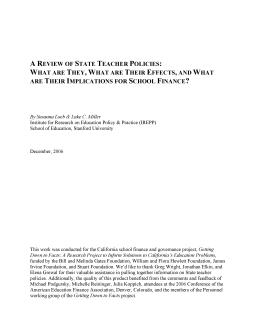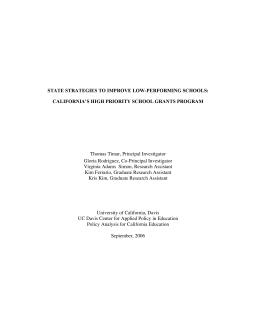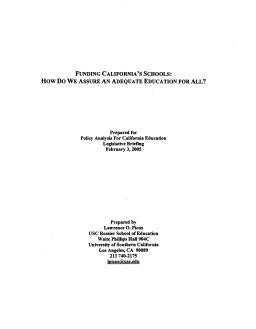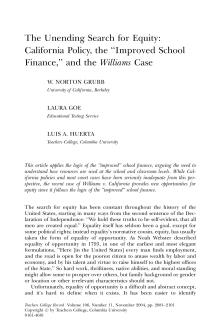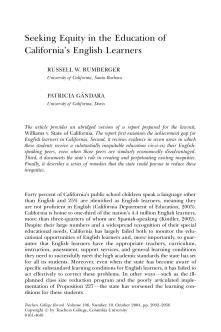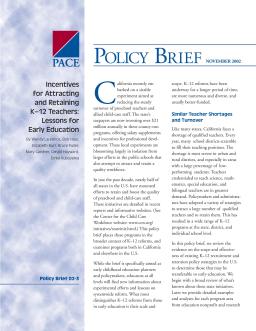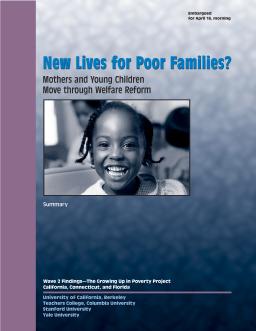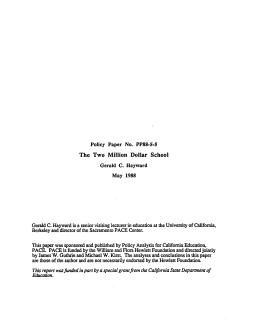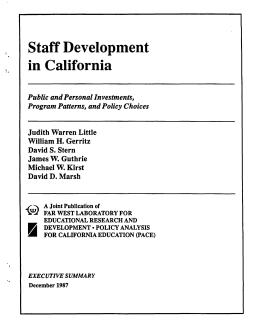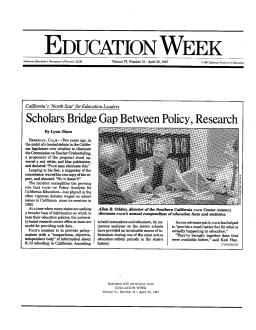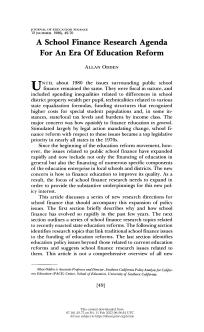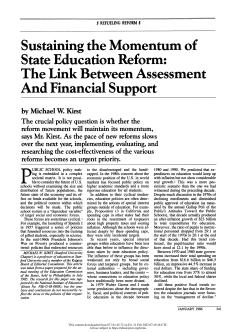Investing in Education Facilities and Stronger Communities
Published
Summary
California is midway through one of the grandest public infrastructure projects ever attempted. Over the coming decade school officials will complete an $82 billion effort, building new schools and renovating old facilities, supported by taxpayers and private investors. But are state officials and local planners building schools mindfully to advance educational quality and lift local communities?
School Finance and Governance in California
Published
Summary
Getting Down to Facts is an extensive investigation of CA's public education system commissioned by a bipartisan group of CA leaders. The project aimed to describe California's school finance and governance systems, identify obstacles hindering resource utilization, and estimate costs to achieve student outcome goals. The project resulted in 23 reports by scholars, which highlight that the current school finance and governance systems fail to help students achieve state performance goals, particularly those from low-income families. The reports provide a framework for assessing reform options.
What Are Their Effects, and What Are Their Implications for School Finance?
Published
Summary
The report explores the impact of teacher sorting, or the tendency for high-achieving students to be assigned to more effective teachers, on student achievement. It finds that teacher sorting has a significant positive effect on student achievement in both math and English language arts. The effects are particularly strong for students who start out low-achieving. The report argues that policies aimed at reducing teacher sorting, such as random assignment of students to teachers, may be counterproductive for student achievement.
California's High Priority School Grants Program
Published
Summary
The report examines the effectiveness of a large-scale performance-based incentive program in California schools. Results show that the program had a small but positive impact on student test scores in math and English, with larger effects in schools with high levels of poverty. However, the authors caution that incentive programs may have unintended consequences and should be implemented with care.
Spinning Out the Implications of the Improved School Finance
Published
Summary
Despite the belief that increased spending leads to better educational outcomes, real expenditures per pupil have doubled since the late 1960s, yet problems in schools persist. An improved school finance approach focuses on effective resources in schools and classrooms that improve valued outcomes, rather than just increasing spending. Clarifying why funding is often wasted and developing new models of connections between revenues, resources, and the results of schooling is essential.
How Do We Assure an Adequate Education for All?
Published
Summary
California ranks 44th in the nation in education spending, spending only 86.1% of the national average per pupil in 2001-02. The recession of the early 2000s resulted in dramatic budget deficits for the state and substantial reductions to the expected level of school funding. Research suggests using the concept of adequacy to estimate the costs of providing an educational program that will enable all—or almost all—children to meet the state's high proficiency standards and offers recommendations for finding additional resources needed to adequately fund California's schools.
California Policy, the "Improved School Finance," and the Williams Case
Published
Summary
This article applies the logic of the ‘‘improved’’ school finance, arguing the need to understand how resources are used at the school and classroom levels. While California policies and most court cases have been seriously inadequate from this perspective, the recent case of Williams v. California provides new opportunities for equity since it follows the logic of the ‘‘improved’’ school finance.
Published
Summary
This article presents a summary of a report prepared for the Williams v. State of California lawsuit, highlighting the achievement gap for English learners in California and seven areas where they receive an inequitable education compared to their English-speaking peers. It also documents the state's role in perpetuating these inequities and proposes remedies to reduce them.
Which Families to Serve First? Who Will Respond?
Published
Summary
This paper discusses extending access to preschool for families in California, focusing on targeting priorities to yield strong enrollment demand and discernible effects on young children's early development and school readiness. It analyzes different targeting mechanisms and suggests experimenting with alternative expansion strategies, rather than investing exclusively in one method. The report also describes which communities would benefit most and considers the criteria for judging the wisdom of targeting options.
Lessons for Early Education
Published
Summary
This policy brief discusses state initiatives in the US aimed at retaining and improving the quality of preschool and childcare staff, with a focus on California's $21 million annual investment. While K-12 reforms have been underway longer and are usually better-funded, early childhood education policymakers and educators will find valuable information about experimental efforts and lessons on systemwide reform.
Mothers and Young Children Move Through Welfare Reform
Published
Summary
This report discusses the lack of knowledge about the impact of welfare-to-work programs on young children since 1996, and how policy leaders are debating ways to aid jobless mothers and enrich their children's lives. The project team followed 948 mothers and preschool-age children for two to four years after the women entered new welfare programs in California, Connecticut, and Florida.
Mothers and Young Children Move Through Welfare Reform: Executive Summary
Published
Summary
This report examines how welfare-to-work programs have affected the lives of young children since 1996, and how they've impacted the home and childcare settings in which they are raised. The study followed 948 mothers and preschool-age children in California, Connecticut, and Florida for two to four years, using interviews, assessments, and visits to homes and childcare settings. The report highlights the major findings from the study.
California's School Voucher Initiative—Proposition 38
Published
Summary
Proposition 38 allows parents in California to obtain a state chit worth $4,000 and move their child from public to private school, which would significantly affect school financing. This policy brief addresses six key questions about the proposal, including its differences from the 1993 voucher initiative, which families would benefit, how it would impact school spending and taxpayers, and the success of voucher experiments in raising achievement.
Published
Summary
In 1987, the Superintendent of Public Instruction released a document detailing the average costs of California schools for 1985-86, providing a brief summary of school expenditures. However, this report lacks in detail, and this report aims to provide more comprehensive and realistic data on school expenditure patterns. The report serves as an analytical base for exploring issues surrounding school expenditures in California, and the data was provided by the state Department of Education staff.
Public and Personal Investments, Program Patterns, and Policy Choices—Executive Summary
Published
Summary
The California Staff Development Policy Study was initiated to assess the possibilities and limitations of staff development in improving classroom teaching and learning. The study aims to answer four questions related to California's investment in staff development, how staff development activities are administered, and how teachers and administrators judge their effectiveness. The study yields eight main conclusions, presented in terms of investment and focusing on improving the capacities and commitments of California's educators.
Published
Summary
PACE, a university-based research center, provides "nonpartisan, objective, independent" information on K-12 schooling in CA. Its analyses have been invaluable to lawmakers and educators during the state's active education-reform period. PACE has played a growing role in debates on school issues, exemplified by a heated debate in the CA legislature over the Commission on Teacher Credentialing. PACE offers a model for providing data for education policies when many states are seeking broader information bases. It has helped provide a better understanding of what is happening in education.
Published
Summary
Before the 1970s, public school finance issues were mainly related to spending inequalities. However, since then, the focus has shifted towards financing education to improve its quality. This article suggests new research directions for school finance that address this policy interest, including topics related to state education reforms, traditional school finance issues, and education policy issues beyond current reforms.
The Link Between Assessment and Financial Support
Published
Summary
Public school policy making is embedded in a complex societal matrix. It is not possible to consider the future of U.S. schools without examining the size and distribution of future populations; the future state of the economy and its effect on funds available for the schools; and the political context within which decisions will be made. The public school system is a "dependent variable" of larger social and economic forces.
Published
Summary
Several state legislatures have acted on recommendations to improve U.S. public schools, resulting in a swift and broad education reform movement. States have expanded school improvement programs, increased high school graduation and college admission requirements, deepened course offerings, and strengthened the teaching profession. Indicators of progress include longer school attendance, tougher academic courses, better counseling, higher achievement test scores, and increased teacher pay. This swift and broad movement gives reason for optimism about its success.
Waivers and School-Based Program Coordination Under AB 777
Published
Summary
California's waiver authority provides school districts relief from Education Code, allowing them to seek alternatives to state requirements subject to local and state review. Waivers are automatically approved unless denied by the State Board of Education, which rarely happens over local objections. Program waivers are rare despite clamor for needed flexibility, possibly due to districts being unaware of the process, viewing it as time-consuming, or using suboptimal local procedures. Oversight hearings are recommended to explore the potential of the waiver process.


